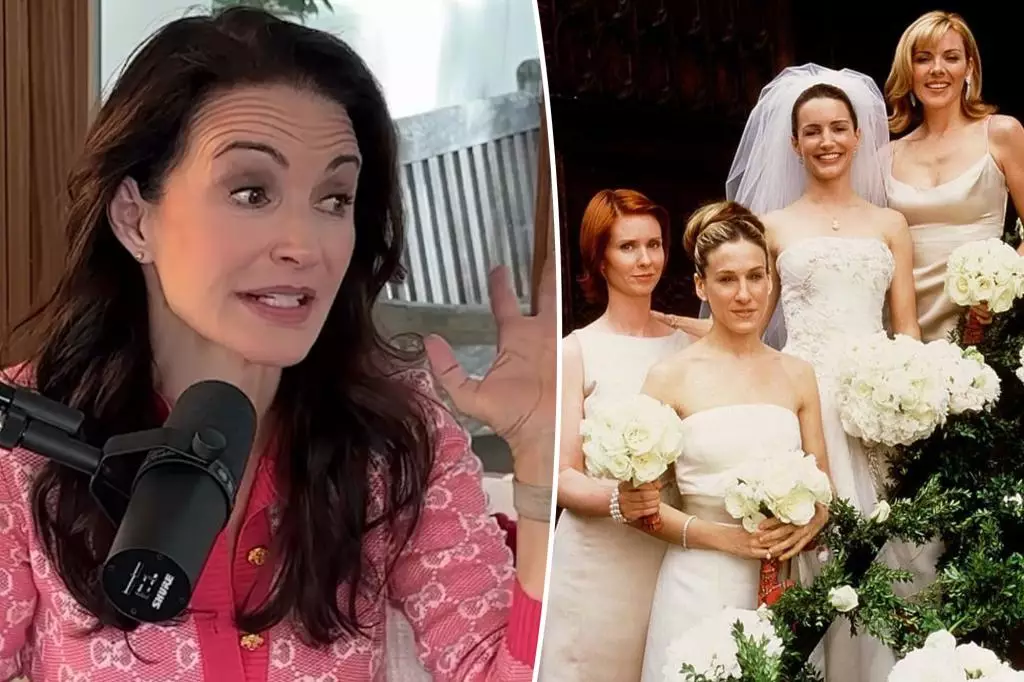The enduring legacy of *Sex and the City* transcends mere narratives of relationships and life in Manhattan; at its heart lies a tapestry woven with fashion, conflict, and character-driven stories. The recent remarks from Kristin Davis—notably known for her portrayal of Charlotte York—highlight the brand of drama that extends beyond the on-screen plots and into the intricate dynamics of the cast’s wardrobe preferences. Davis claims that Sarah Jessica Parker, who embodies the iconic Carrie Bradshaw, might still be harboring resentment over a clothing debacle that unfolded during the pivotal wedding episode in Season 3.
Set against the vivid backdrop of New York City’s cultural zeitgeist in the early 2000s, this wardrobe conflict is a reminder of how deeply connected characters are to the material they wear. Charlotte’s wedding to Trey MacDougal, featured in the episode “Don’t Ask, Don’t Tell,” serves as a focal point during which tensions emerged over the bridesmaids’ attire. The bridesmaid dresses, designed by the esteemed Vera Wang, were set in a neutral beige shade—a subtle nod to the understated elegance of the bridal gown—but Parker’s staunch discontent regarding the color choice culminated in more than just unspoken differences. Davis articulated that Parker was “still mad” at the choice, indicating the potential emotional undercurrents tied to character identities and actress preferences.
A Deeper Dive into Character Alignment and Discontent
The emotional turmoil surrounding the wardrobe choices reflects a broader theme of character alignment and expression. Each character’s style has always been intricately tied to their personal journeys, and clothing decisions were often emblematic of bigger conflicts. Parker’s desire to modify her bridesmaid dress serves as a manifestation of a deeper struggle for creative expression on set. The anecdote shared by showrunner Michael Patrick King reveals just how deeply Parker felt about her attire, going so far as to chop and reassemble her gown to incorporate tartan elements—symbolically resonating with Trey’s Scottish heritage. Such an act of rebellion in a costume reflects the actress’s unwillingness to conform, which at its core, is an extension of Carrie Bradshaw’s character herself.
Fashion has always played an integral role in *Sex and the City*, often serving as both a narrative device and a form of self-expression for its characters. The fact that Davis had to mediate Parker’s discontent during the filming process reveals a collaboration teetering on the edge of collision. Davis’s reaction—that it was indeed Charlotte’s day, hence the need for matching bridesmaid dresses—indicates her alignment with the internal logic of the show’s narrative choices. This juxtaposition between character integrity and personal liberty mirrors broader themes of female empowerment and the struggles women often face in navigating collective identity versus individual aspirations.
The overall impact of such wardrobe spats goes beyond personal grievances. Fashion in *Sex and the City* has often been credited with setting trends, influencing culture, and even redefining relationship dynamics among women. As the characters embrace various styles—ranging from Charlotte’s quintessentially feminine flair to Carrie’s avant-garde choices—their unique silhouettes serve as metaphors for their individual arcs. In subsequent discussions with King, Davis muses about the contrasting gown styles from Carrie’s wedding in the franchise’s film adaptation, indicating an intentional deviation from uniformity, perhaps reflecting the evolution of both character development and personal relationships.
As the years have rolled by, the interplay of fashion and personal disputes on the *Sex and the City* set is illustrative not only of the complexities within this beloved series but also of the shared journeys among the women portrayed. Whether through the lens of rivalry or cohesion, the clothes they wore fabricated an enduring legacy that continues to captivate audiences. This admission of past grievances signals how fashion remains an indelible chapter in their story—not merely a backdrop but a vital narrative force in shaping their personal and professional lives.

